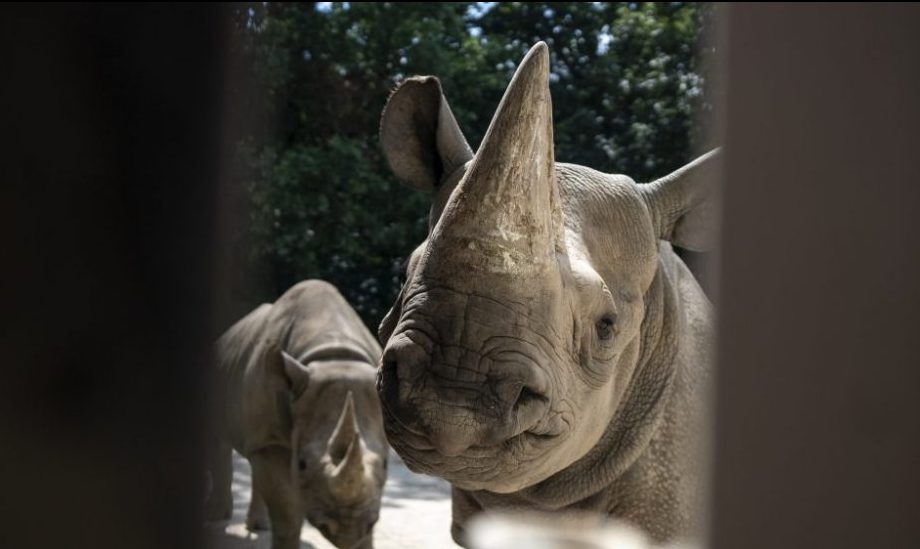
Rwanda’s commitment to protecting and investing in its National Parks is phenomenal. The annual Kwita Izina gorilla naming ceremony is one example of that.
“On Sunday June 23, five critically endangered Eastern Black Rhinoceroses, born and bred in European zoo environments, will be flown 6,000 km to Akagera National Park in Rwanda. This is the largest ever translocation of rhinos from Europe to Africa.
This historic journey will begin at Safari Park Dvůr Králové (Czech Republic) where all five animals have been gathered since November 2018.

While their flight departs on Sunday June 23rd, their journey began years ago, through EAZA’s vision to supplement wild populations in secure parks in Africa with genetically-robust individuals who have been successfully bred and cared for over the years by the EAZA Ex Situ Programme (EEP).
This is a unique collaboration between the European Association of Zoos and Aquaria (EAZA), the Government of Rwanda and conservation NGO African Parks.
Fewer than 5,000 wild black rhinos and only 1,000 Eastern Black Rhinos remain in Africa; and their future is severely threatened by poaching for the illegal demand for their horns. This translocation project represents an urgent and valuable opportunity to expand the range and protection of the black rhino, and demonstrate how captive rhinos can help supplement and repopulate wild populations within secure landscapes.
Three female and two male black rhinos, ranging between two to nine years old, were chosen. Jasiri, Jasmina and Manny were born in Safari Park Dvůr Králové (Czech Republic); Olmoti comes from Flamingo Land (United Kingdom) and Mandela is from Ree Park Safari (Denmark). The rhinos are being donated to the Rwanda Development Board (RDB), the government body that manages Akagera National Park, the rhino’s new home in Rwanda, in partnership with African Parks.
All five rhinos have undergone months of sensitisation to prepare them and minimise stress to ensure the safest journey possible. During the voyage, which will be approximately 30 hours long, they will be inside custom-made crates, and fed and watered regularly. Experienced zookeepers from the Safari Park Dvůr Králové as well as veterinarian Dr. Pete Morkel, a world expert in rhino translocations, will accompany and monitor the rhinos throughout the entire trip, as well as their release into the Park.
“By undertaking a highly supervised and well-planned gradual acclimation process, we believe these rhinos will adapt well to their new environment in Rwanda. They will first be kept in bomas – enclosures made by wooden poles. Later, they will enjoy larger enclosures in a specially protected area. The final step will be to release them into the northern part of the national park where they will roam free,“ said Přemysl Rabas, Director of Safari Park Dvůr Králové.

Akagera National Park is an ideal destination for the reintroduction of the animals.
Rhinos were first reintroduced in 2017 – a decade after they were last seen in the country. In that year, African Parks successfully translocated 18 Eastern black rhinos from South Africa to Akagera in collaboration with RDB and the Howard G. Buffett Foundation. The translocation entailed a 2,485-mile journey. This success is testament to both the potential of the park to sustain a rhino population, but also to the high levels of security and effective park management. You can read more about that translocation on the African Parks website.
This video is from 2017.
Since 2010, the Park has undergone a revival with poaching practically eliminated, allowing for key species to be reintroduced. In 2015 lions were reintroduced and have since tripled in number [see photo below]. Strong community conservation efforts have resulted in tremendous support for the Park, and tourism is now leading to Akagera being 80% self-financing, generating US $2 million a year, which goes back to the Park and surrounding communities.
“We have been preparing for this moment for years and are excited to build on our efforts to revitalize the Park with the RDB and the successful introduction of the first round of rhinos in 2017,“ said Jes Gruner, Park Manager of Akagera National Park. “This transport of five rhinos from Europe is historic and symbolic, and shows what is possible when dedicated partners collaborate to help protect and restore a truly endangered species.”
These conditions also will allow for the ongoing study of the five animals from Europe and the existing population as they gradually integrate to contribute to a stable population of black rhinoceros in East Africa. The Park is a key component of the Government of Rwanda’s strategy to foster economic growth while providing a secure future for wildlife in the country.
“The translocation of five rhinos from European zoos to Rwanda will further enhance the natural ecosystem in Akagera National Park. This partnership with our European friends is a testament to Rwanda’s commitment to conservation. Today, poaching is almost non-existent in our four national parks and we are confident that these rhinos will thrive in their natural habitat in Akagera. They are a positive addition to Akagera, a Park where tourists can now visit the African Big Five,” said Clare Akamanzi, Chief Executive Officer, RDB.
The Rwanda Development Board is responsible for ensuring that the tourism and conservation goals of the Government of Rwanda are successfully implemented.
The European Association of Zoos and Aquaria comprises more than 400 zoos, aquariums and other institutions across 48 countries, collaborating for the advancement of conservation, research and education. EAZA Ex Situ Programmes is responsible for the planning and administration of over 200 programmes.
Safari Park Dvůr Králové is one of the best rhino breeders outside of Africa. So far, 46 black rhinos have been born there and the park coordinates efforts to save the northern white rhino. The park assists with conservation of rhinos, even in the wild. In 2014 and 2017, the park organized public burnings of rhino horn stockpiles to raise awareness of the plight of rhinos.
The Akagera Management Company (AMC) is a public-private partnership between RDB and African Parks and has been responsible for fully managing Akagera National Park since 2010. African Parks manages 15 national parks and protected areas covering over 10.5 million hectares in Benin, Central African Republic, Chad, the Democratic Republic of Congo, the Republic of Congo, Malawi, Mozambique, Rwanda, Zambia.”
To follow the progress of the rhinos follow #rhinostorwanda on Twitter.
The rebirth of Akagera
Akagera is almost unrecognisable today from what it had become 20 years ago when it seemed destined to be lost forever. While peace was finally restored after the 1994 Genocide against Tutsis, Akagera’s demise was just starting. Refugees returning to Rwanda after the genocide were battling to survive. Forests were cut for timber and the park’s savannah became home to tens of thousands of long-horned cattle that displaced wildlife. Rhinos disappeared and lions were hunted to local extinction. The park’s value was “diminished to the point of not existing at all.” This makes Akagera’s revival even more remarkable.

To be honest, I didn’t expect to see a lot of wildlife when I first went on safari to Akagera National Park three years ago (working in conservation in Uganda may have spoiled me!) I was therefore thrilled beyond words to see a leopard (just a few metres from us). Later we spent half an hour in the company of three young lions, offspring of the first lions reintroduced to the park.



























An update from African Parks reads:
“We received over 49,000 total visitors in 2019; a 12% increase on 2018
48% of those visiting Akagera are Rwandan Nationals
Over USD 2.5 million net was generated in park revenue, up by almost 25% on 2018.
Nearly 90% self-financing
Ruzizi Tented Lodge continues to receive rave reviews on TripAdvisor and received the Certificate of Excellence for the 5th year in a row! This year we opened a massage hut where guests can really unwind after a day in the park. Due to increasing demand, we extended the open months for the seasonal Karenge Bush Camp.
2,000 local students, 329 teachers and 300 local leaders, visited Akagera for a day trip as part of the parks’ annual environmental education programme
In the Lions Cup Football Tournament 16 men’s and 9 women’s football teams participated attracting 31,450 spectators across all matches and the Rhino Velo Race attracted 123 participants and over 3,000 spectators on the day.
2019 saw the opening of the Community Centre; a multi-use space outside the park including an example of the vegetable garden, bee-keeping and chicken rearing, tree nursery, shop for local craft, and an education centre. Construction for the dormitories is underway.
16,520 trees planted mostly at schools in 10 different locations bordering the park
A honey building at the community centre is now a fully equipped facility for honey collection, filtering, storing, processing and packaging and a bee-keepers union was created. over 8,000kgs in total harvested from bee-keeping cooperatives working with Akagera over the year.
USD $525,000 directly contributing to the local community through salaries of local staff and local purchases in 2019.
The aerial census for 2019 has shown an increase in overall animal numbers with a total of 13,500 animals recorded. This is up from 12,000 counted in 2017.
Three Rwandan Rangers, two from Akagera National Park, received the Paradise Foundation African Rangers Award. Leonidas Mpumuje and Anthony Nzuki were among the 50 park rangers recognised in this year’s African Rangers Award, the ceremony was held in November in Accra, Ghana and attended by Leonidas.
An intensive six-week training programme in Akagera, jointly organised by the park management and the Government of Rwanda, saw 47 new rangers passing out. 22 of the new rangers are now working in Akagera. New rhino monitoring team were recruited and trained for the north of Akagera
Four Akagera Guides participated in an advanced bird training exercise organized by the Rwanda Development Board (RDB), in partnership with the German Development Corporation (GIZ) and Rwanda Safari Guides Association (RSGA) aimed at improving the bird watching experience in Rwanda.
Shakani, Akagera’s only lakeshore campsite, was renovated with new camp toilets and solar hot water showers making Shakani the first and only campsite with flushing toilets and warm water!
Akagera’s first concession, a five start tented lodge, opened on Magashi Peninsula. Magashi Lodge, operated by Wilderness Safaris, opened in May with six spacious tents overlooking beautiful Lake Rwanyakizinga.”